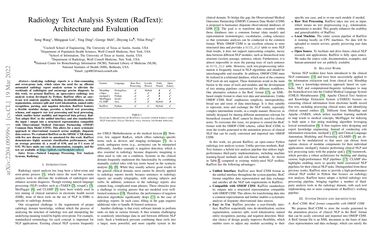Radiology Text Analysis System (RadText): Architecture and Evaluation
Analyzing radiology reports is a time-consuming and error-prone task, which raises the need for an efficient automated radiology report analysis system to alleviate the workloads of radiologists and encourage precise diagnosis. In this work, we present RadText, an open-source radiology text analysis system developed by Python. RadText offers an easy-to-use text analysis pipeline, including de-identification, section segmentation, sentence split and word tokenization, named entity recognition, parsing, and negation detection. RadText features a flexible modular design, provides a hybrid text processing schema, and supports raw text processing and local processing, which enables better usability and improved data privacy. RadText adopts BioC as the unified interface, and also standardizes the input / output into a structured representation compatible with Observational Medical Outcomes Partnership (OMOP) Common Data Model (CDM). This allows for a more systematic approach to observational research across multiple, disparate data sources. We evaluated RadText on the MIMIC-CXR dataset, with five new disease labels we annotated for this work. RadText demonstrates highly accurate classification performances, with an average precision of, a recall of 0.94, and an F-1 score of 0.92. We have made our code, documentation, examples, and the test set available at https://github.com/bionlplab/radtext .
PDF Abstract

